By John Berardi, Ph.D.
If you’re new to health, fitness, or nutrition coaching you’ve probably worried — at least a little — about how you’re going to get clients. Especially in this age of paid search, Facebook ads, and more. Well, worry no longer. These simple, fast, and free client acquisition strategies will help you get your first few clients. Or, if you already have a few, they’ll help you get a few more.
After coaching over 50,000 health, fitness, and wellness professionals through the Precision Nutrition Certification program, I’ve learned that new coaches (or coaches going out on their own for the first time) struggle most with one thing:
Getting new clients.
That’s totally understandable.
Beyond the early discomfort many new pros feel around learning “sales” and “marketing”, it’s also easy to get a little intimidated when looking at established brands and seeing the big audiences they’ve built, the content they’re creating, or the ads they’re running.
“JB, how can I compete?”
“I don’t even know the first thing about marketing funnels.”
“And who’s got that kind of money to invest in ads?”
While I can totally empathize with these feelings, I’ve got some good news:
You don’t have to compete!
Instead, you have to start at the beginning, just as those companies did. You start by going from zero to a few clients. Then you go from a few clients to a few more.
Even better news?
Getting your first few (or your next few) clients is cheap and easy.
You don’t need to master SEO, or spend money that you don’t yet have on Facebook ads, or build a big Instagram following.
Yes, those are the things getting attention today. But, for someone just starting out, they’re a distraction from the real work, which I’ll share below.
Indeed, use any of the three strategies I’m about to share and you’ll be shocked and amazed at how cheap and easy it is to attract your first few clients.
But, before the strategies, do you even know what you’re selling?
If I pressed, you’d probably give me a bunch of really smart answers:
“JB, of course, I know what I’m selling!”
“I’m selling evidence-based nutrition coaching!”
“I’m selling my thousand years of education and master-level expertise!”
“I’m selling my slick, efficient online coaching platform!”
And I’ll say:
No, you’re not.
Here’s something that might sound confusing at first, but will change the way you view your business, and how powerfully you attract clients.
No one wants nutrition, exercise, or lifestyle coaching.
No one wants daily practices, new habits, or lessons and thought exercises. No one wants custom workouts. No one wants diets, meal plans, or menus.
No one wants the product or service you’re selling.
What people want is to become a better version of themselves.
This image (from this excellent post) says it all:
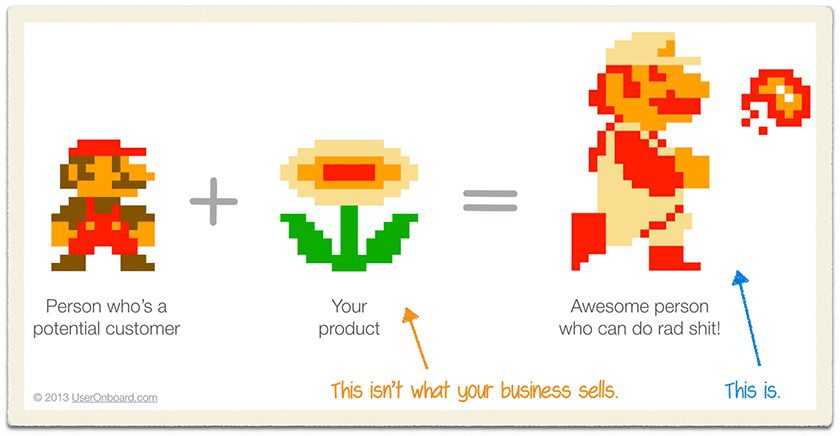
You see, people don’t buy a university degree or certification, they buy the promise of ending up more knowledgeable, smarter, and (maybe) more employable.
People don’t buy canvas shoes or fancy sunglasses, they buy the idea of looking cooler, having special things, and making a fashion statement.
Likewise, people don’t buy nutrition coaching, they buy a hopeful vision of their future, one where they are healthier, stronger, and happier.
In other words, you’re not the subject of a sales pitch, your client is.
Make them the hero of the story.
In essence, it’s your job to show them how working with you will turn them into an “Awesome person who can do rad stuff!”
For now, onto your “get a few new clients” strategies.
Strategy #1:
Survey Selling
Survey selling is something we do extensively, and very effectively, at Precision Nutrition. But we do it in a more complex, “scaled-up” kinda way.
You probably don’t need all that.
Which is why I love sharing this simpler way of doing survey selling from my friend Jon Goodman, of the Personal Trainer Development Centre and OnlineTrainer.com.
Jon’s strategy involves creating a simple survey (using Google Forms) that you can post on social media to attract the exact kind of client you’re after.
Here’s how to do it.
First, think about the type of person you want to serve.
Write down your ideal client’s:
- Age range
- Gender
- Specific goal
- Potential limitations
Here are two examples of what you might come up with:
My ideal clients are 20-30-year-old guys who want to lose a bit of fat and put on 5-10 lbs of muscle and have no serious injuries.
My ideal clients are 45-55-year-old females who want to lose no more than 10 lbs of fat but feel like they’ve tried everything and nothing seems to work.
Next, create a Google Form.
(If you don’t know how to make a Google form, click here for a tutorial.)
When starting a new survey, according to Jon’s method, you’ll need to create:
- a title
- a compelling description,
- a few demographic + contact info questions
Here’s an example of what you might come up with:
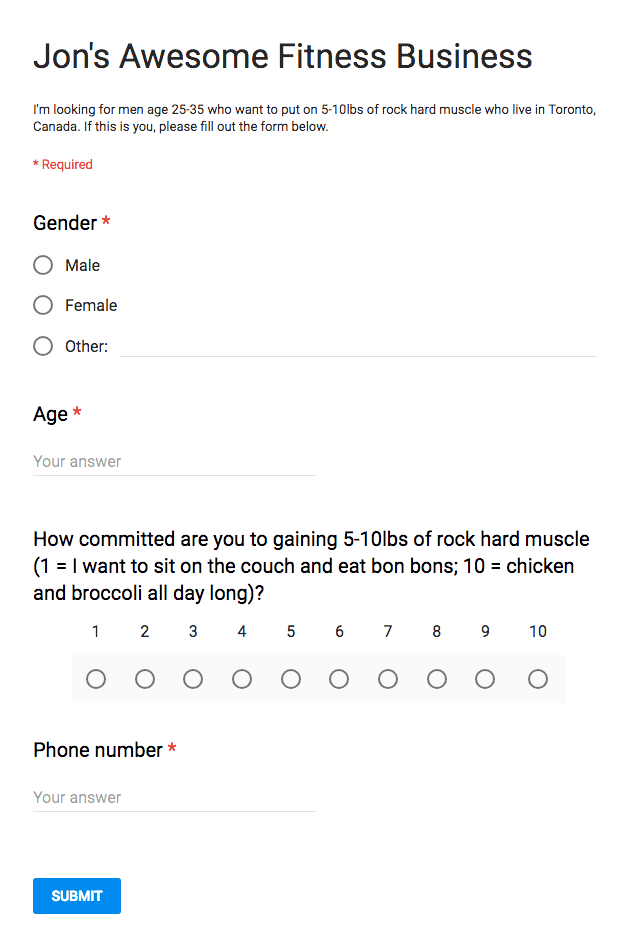
Feel free to copy the exact format above, adjusting the title and description to match what you’re offering.
When it comes to the description, here’s the formula:
“I’m looking for {number of people} {gender} ages {age range} who live in {your location} and are looking to {goal}. If this is you, please fill out the form below.
All eligible applications will be contacted by phone.”
Once you’re happy with the form, click “Send” at the top right and select the link icon in the pop-up window. This will give you a direct link to your form.
Be sure to save that link somewhere.
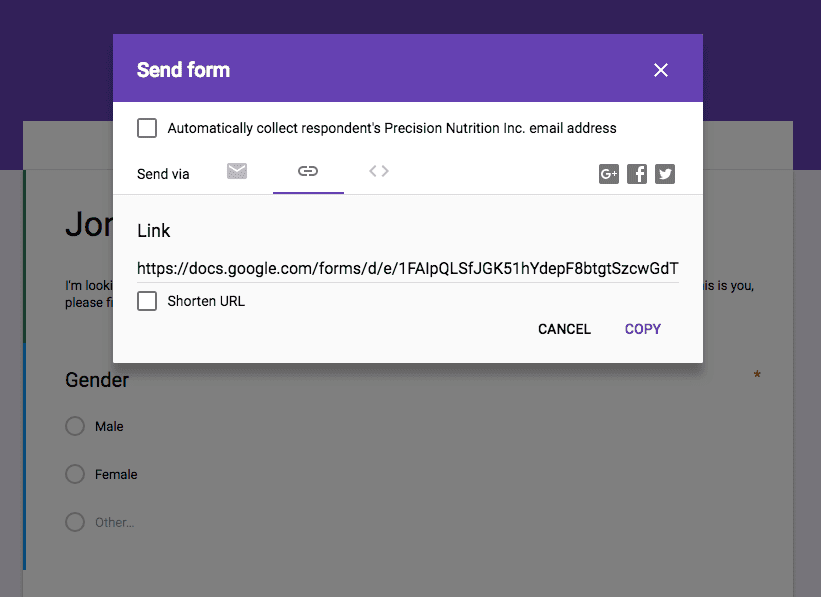
Finally, enable notifications so that you’ll be emailed every time a prospective client submits a completed form. To do this, go to your Google Drive, select your form, and click on the header titled “Responses”.
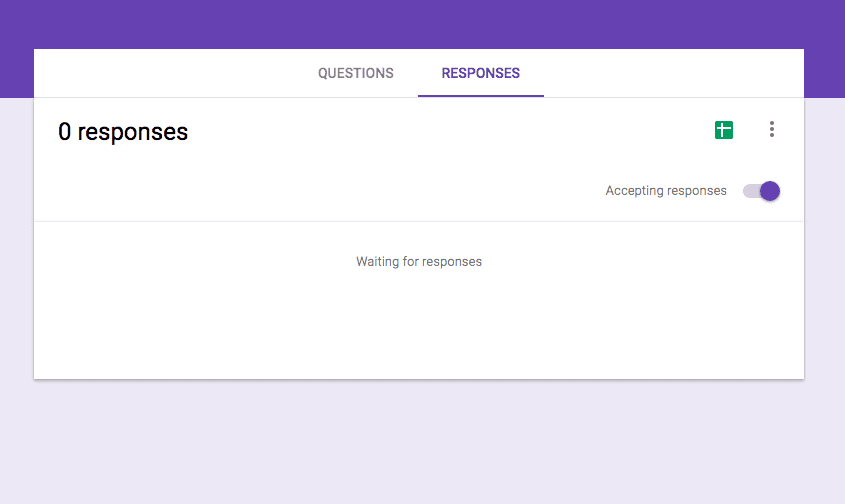
Then click the “Create spreadsheet” icon, which will redirect you to a Google spreadsheet.
In the spreadsheet page, click “Tools” at the top and select “Notification rules”.
A window will pop up with an option to have the system email you whenever users submit, either immediately, or collected into a daily digest. Select your preference.
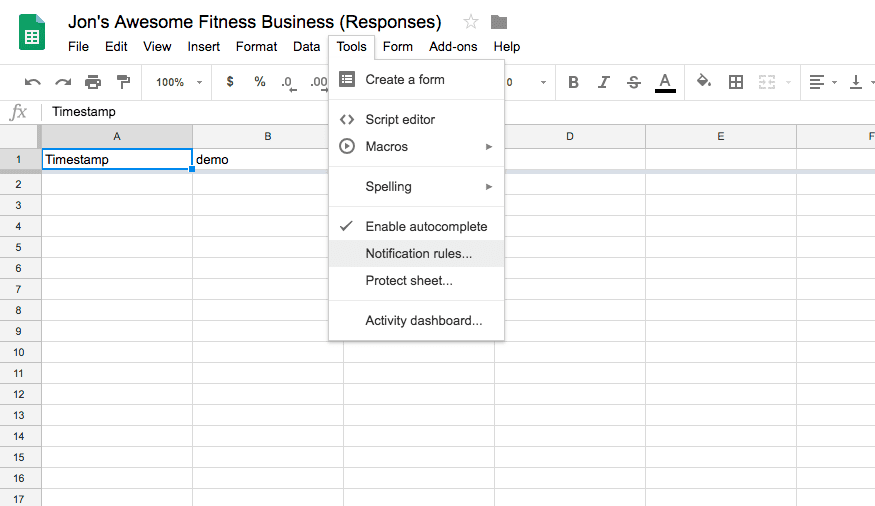
Finally, share your survey on Facebook, Instagram, wherever.
For example, on Instagram change your description link to your survey link and upload a pic saying that you’re taking on clients (specific to the type) and use the script below, which directs people to click the link.
And, on Facebook, you’ll share a status update with the same script (below) that links to your form. Here’s your script:
***I’m looking for {number of people} {gender} ages {age range} looking to {goal} that live in {location}.***
I am looking for {gender} who want to:
-{benefit 1}
-{benefit 2}
-{benefit 3}
Spots are extremely limited and I’m only looking for {number of people} who are ready to make a change today. To apply, fill out the quick survey below and I’ll be in touch if you meet the requirements:
===> {link to your Google form}
The benefits you include will vary but they should speak to the hopeful future I described earlier. In other words, list things that help them envision becoming an “Awesome person who can do rad stuff!”
Note: You can use this method on any platform, via email, whatever. Just get the message out there and send people to your survey.
Be sure to call them right away.
Ideally, you’ll call people within 20 minutes of them filling out your survey. I don’t care what you’re doing. Strike while it’s hot.
Go through the same process that you would on any other sales call.
(If you’re not sure how sales calls should go, check out Jon’s article: Selling Personal Training in 5 Steps).
Keep following up.
If they answer, it’s a great call, and you sell/book them in for an appointment, and they show up… go ahead and dance your happy dance.
If they don’t answer, if they answer but don’t book an appointment, or if they answer and book an appointment but don’t show up… keep following up once a week for the first month. And once a month after that until they become a client or ask you to stop calling.
And, folks, that’s pretty much it.
If you decide to try this method, you’ll be up and running with your first post, for free, inside of 30 minutes. And, most people who try it, report getting 1-3 new clients within a day or two.
No joke.
Even if you think this is too simple, or couldn’t possibly work, try it anyway. People constantly tell me that they would have never expected something like this to help them… but that it did, big-time.
Strategy #2:
The “Tell People What You Do” Challenge
In our ProCoach Facebook group, we recently did a 2-week challenge. Coaches were encouraged to do something incredibly simple (yet radical in 2018, it seems).
They were asked to talk to people.
You know, like, real people. In real life.
Specifically, we asked them to tell one person a day what they do. That person could be anyone: the barista that frothed the milk on their latte, the cashier at the grocery store, or the lady sitting next to them on their commuter train.
The goal was to develop a “script” about what they do, get comfortable talking about it and maybe even get a new client or a referral.
Our coaches went nuts. It kinda blew everyone’s minds.
Some of our coaches felt that icky stretch feeling you get when growth is happening. ProCoach Melissa Dow found she had to override her usual instinct to wait for people to come to her. “It was uncomfortable, but that’s where learning begins, right?” she says.
Many found they got better at it along the way, like ProCoach Beth Balcezak Daugherty who found that although she often felt hesitant before reaching out, most people thanked her afterward. “It got easier!” she reassures us.
ProCoach Jen Kates also found it got easier: “IT DOESN’T SUCK, AND IT’S ACTUALLY A LOT OF FUN ONCE YOU GET OVER THE HURDLE!!!” (Note: The caps and exclamation points are hers.)
At the conclusion of the challenge, many coaches remarked on the tremendous potential of this simple act.
“The biggest takeaway from this process for me was just how many opportunities there are hidden in plain view,” said ProCoach Simon Dannapfel.
Interested in trying this challenge yourself?
Here’s how to do it:
Build your elevator pitch.
Begin by making sure you can actually describe what you do without rambling and without boring listeners with irrelevant details.
A simple way to do this is to fill in the following blanks.
“I help {kind of person}
to {action/benefit}
so that they can {brighter future/more inspiring benefit}.”
Here are some examples of what you might come up with:
“I help {new moms}, to {get active and eat better} so that they can {drop their baby weight and feel more energy}.”
“I help {busy executives}, to {find time in their schedule for healthy habits}, so they can {finally get their health under control}.”
“I help {young athletes}, to {improve their movement quality}, so that they can {dominate on the playing field & injury-proof themselves}.”
“I help {people in their 60s and 70s}, to {begin a new movement practice}, so they can {walk, jump, run, & play with their grandkids}.”
Next, pick a person (any person) every day to talk to.
Approach folks however you like to get the conversation started.
If you’re not sure how to do that without coming off creepy, break the ice with something like this:
“Hey!
I’m doing this 2-week challenge where I have to tell someone about what I do, and you’re who I chose today!”
“Is that cool?”
Then lay the elevator pitch — or something like it — on them.
And, if they seem interested, expand on it.
If you make a genuine connection, ask if you can follow up.
The conversation could end pleasantly but without any real interest on their part. That’s totally fine. You will still benefit from the practice.
However, should they express real interest, keep the conversation going with something like:
“Hey, thanks for listening today. Mission accomplished on the contest!
Before I roll, you seemed kinda interested in {some aspect of what you talked about} and a really cool resource just popped into my head that I’d love to share.
Could you write down your email address so I can send it over?
(Alternatively, you can get their cell number, FB page, or whatever).
Just so you know, “no” is a fine answer here. After all, we just met. However, I do think you’ll dig it. And I promise not to bug you beyond that.”
Then give them something awesome!
If they share their email address, wait a day and follow up with a cool article, some recipes, an infographic, an inspiring YouTube video, whatever you think will be helpful and is in line with what you talked about.
It doesn’t have to be your own content. Just something that’s high quality and will be genuinely helpful.
“Hi!
It’s {your name], we met yesterday at {place} and we talked about {topic}.
Wanted to follow up with {the thing I promised}, which I think you’ll like.
Here’s the link:
{link to the thing here}
No obligation to {watch it, read it, etc}. I just thought it might help.”
If they respond, remind them about your services.
If they follow up, reply with a casual reference to your services.
“Thanks for the note!
I’m so glad you liked {the thing you sent}!
I don’t know if you, or anyone you know, would be interested in this… but I’m running this program that starts in two weeks.
I’ll be working with {number of people} {gender} ages {age range} looking to {goal} that live in {location}.
Spots are extremely limited and I’m only looking for {number of people}.
Let me know if you’re interested by filling out this super-quick survey below.
===> {link to your Google form}
Again, no pressure. Just sharing this in case you, or a friend might be interested.”
So there you have it.
A step-by-step guide on how to talk to people, and how to follow-up in a non-creepy, not-overly-pushy kind of way.
The point of this exercise is to show you that there are potential clients everywhere.
You just need to speak up so they know you’re there.
Strategy #3:
Leverage Your Existing Communities
Many of us belong to one group, or a host of them, either online or in-person.
These are often unrelated to health and fitness, which — in this case — is a good thing as it gives you the opportunity to share what you do with a novel audience.
For example, you might be part of:
- A Facebook group for new moms, because hey! You have spit-up on your shirt too!
- A Saturday morning bring-your-dog-and-hike group. People who love dogs and all-terrain boots??! Your tail is wagging.
- An online forum for people who dig classic cars. Mustang Fastback? I’m all in.
- A faith community where you worship once a week plus participate in community service activities together.
- A weekly online mastermind group of career-change-entrepreneurs. You all have great stories about the day you broke free from corporate shackles.
If you do it right, these groups can be an amazing source of new clients.
ProCoach Carolina Belmares has a great story of how she used this method.
Carolina is from Mexico but currently lives just outside of Toronto, Canada. She joined a Facebook group for Mexican women living abroad.
Carolina was genuinely excited to connect to this group of women and took her time getting to know them. She responded to people’s posts and posted her own successes and woes living abroad as a Mexican woman.
She took note of the tone and “vibe” of this group, and generally just tried to be kind, helpful, and supportive to the other members without talking much about what she does for a living.
After a while, she posted about her coaching work.
It was more of a “this is my life story” kind of post, but she also happened to mention that she was an online nutrition coach and dropped some information about a program she was running that was starting soon.
In Carolina’s words, “The response was beyond insane.”
Not long after she posted, her tally was:
714 reactions to the original post
181 comments asking for more information
259 new “Likes” on her personal coaching Facebook page
83 brand new subscriptions to her mailing list
Too many private messages to count
Not bad for a free group that you were interested in hanging out with anyway.
To try this method yourself:
Consider the groups you’re currently a member of (online or in person).
If you’re not a member of any, consider whether there are any groups you’d like to be a part of and would be good candidates for your coaching. (Remember, it’s better if they’re not fitness or nutrition groups).
Engage with the group in an authentic, helpful, supportive way.
Don’t just go joining groups to make your elevator pitch as “pitching” in groups is universally frowned upon. Instead, become a real part of the community and only talk about what you do if it’s relevant to the conversations already going on.
If a fitness or nutrition topic comes up, bingo!
Be the biggest keener in the room. Help answer questions. Offer support. Send people helpful links, articles, videos, and other resources. But, still, hold back a little on mentioning your services.
After you’ve built some trust and genuine connections, mention your services.
Have your information easily available if people want it, but don’t be pushy about it. If you need a ratio to work with, then let’s say for every 10 genuine, non-work related comments, you can slide in something about your coaching.
In the end, joining a group is one of the most mutually beneficial methods for building your practice. You’ll have access to a wide audience to which you can extend help and support, but you’ll also get connect with “your people”.
What to do next:
Some tips from Precision Nutrition
In this article, we’ve outlined a few highly effective strategies for getting a few new clients, or the next few after that. Begin with…
Knowing the “why” of what you’re selling, not just the “what”.
Spend time thinking about what prospective clients want their lives to be like. And how you can start connecting your coaching to those outcomes.
Again, you’re not selling your superstar nutrition knowledge, your sleek online program, or even health coaching.
You’re selling possibility to your clients: the possibility to feel, look, and move better; to gain more confidence, strength, and resilience; to have a better life.
Refine your elevator pitch.
Come up with a concise way of describing how you help people.
“I help {kind of person}
to {action/benefit}
so that they can {brighter future/more inspiring benefit}.”
Pick a challenge, any challenge.
The above strategies only work if you practice them. Not just once, but consistently. (Remember, they get easier the more you do them!)
So pick one of the client-attracting methods above. Anyone will do.
And get started today.
I mean, like, right now.
Even if you don’t know how to do it perfectly yet, start anyway. Because perfection is often the enemy of action.
Stay consistent.
Once you deploy one, or more, of the methods above, challenge yourself to stick with it for at least a month.
For extra points, use a calendar to track your consistency and your results. At the end of the period, evaluate your progress. Did it work? If not, was there something about the way you executed it that could be refined?
Practicing these methods will show you precisely where you need to grow.
Does your voice shake every time you talk to a new person? No sweat, that just means you need more practice talking to strangers.
Did your Google Form get zero clicks? Maybe you need to work on your written communication.
Did someone call you a know-it-all jerk on your Facebook group? Maybe you need to practice coming off as less judgmental and more compassionate.
Failure isn’t possible here. Everything you get back from this practice is simply feedback to inform future growth.
Learn to follow up.
In all of these methods, following up is key.
Remember that when people are considering change, they often start out with ambivalence. They’re kinda interested in taking the leap, but also kinda scared and inclined to stay safe under the covers.
Following up with people can gently move them towards ready-to-take-a-leap.
But selling without looking sleazy is an art. If you push too hard with people, it can have the opposite effect.
In your early follow-ups with someone, aim simply to be useful and offer support. Send them cool content, ask them about their challenges, and encourage them.
When you sense some interest, subtly mention your services, in a “no pressure” kind of way. Let them know you’re available when they’re ready.

